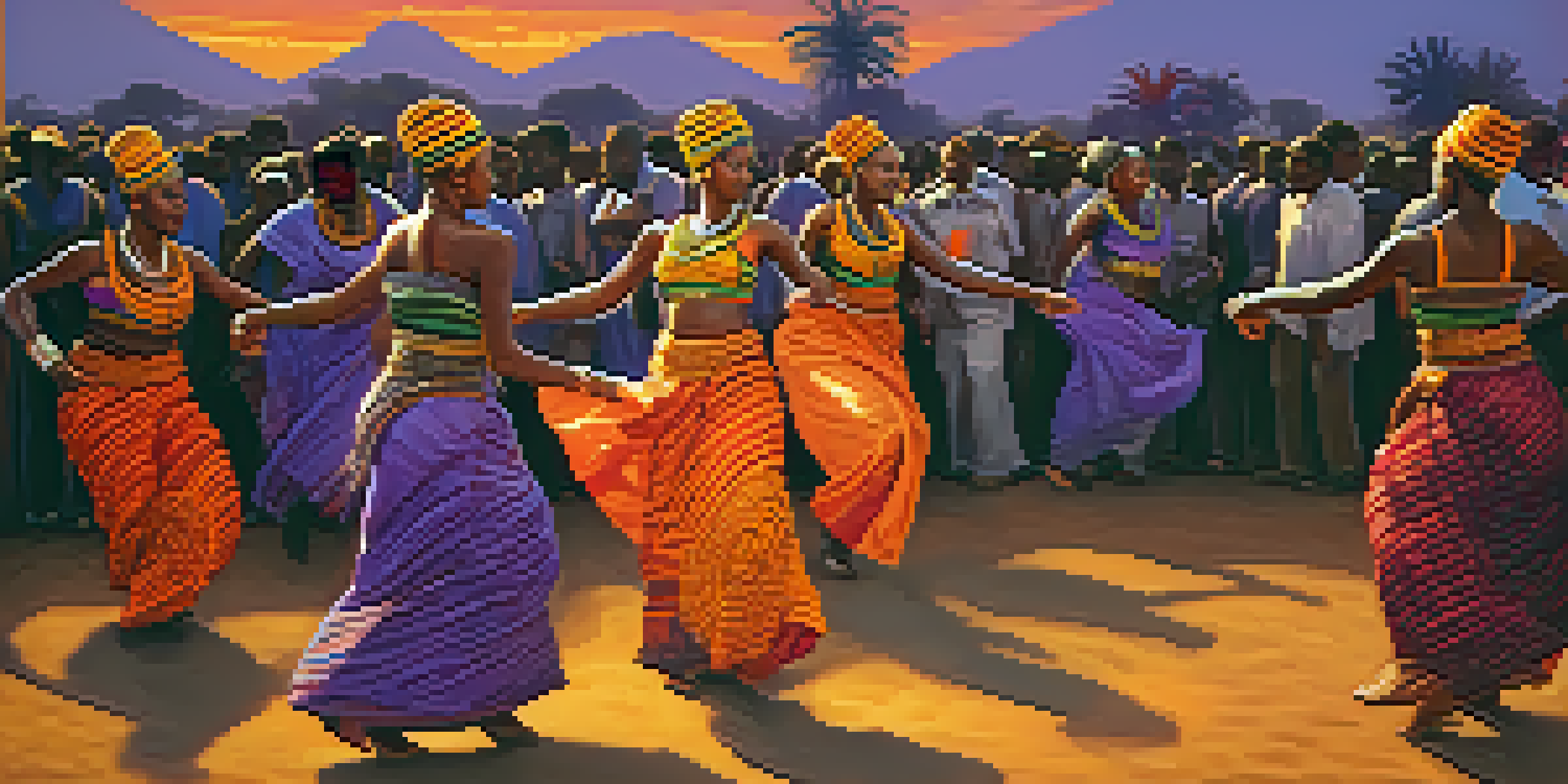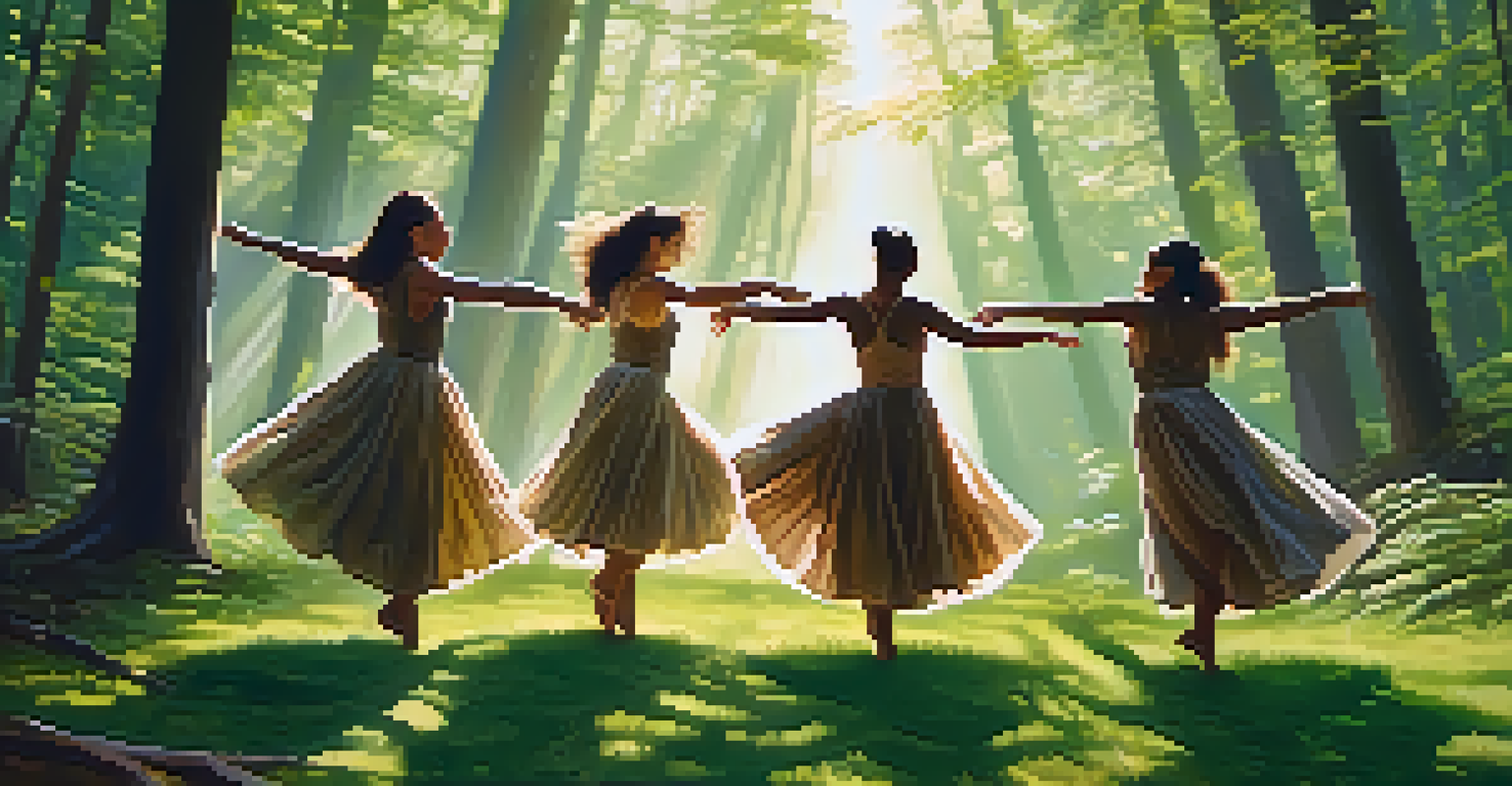Understanding the Spirituality of Dance in African Traditions

The Essence of Dance in African Spirituality
Dance is more than just movement; it often serves as a vital expression of spirituality in many African traditions. It acts as a bridge between the physical and spiritual worlds, allowing individuals to connect with ancestors and divine forces. In various cultures, dance is a communal activity that fosters unity and shared spiritual experiences.
Dance is the hidden language of the soul.
For instance, during rituals or ceremonies, dance becomes a medium through which participants can express their reverence and gratitude. This deep-rooted connection highlights how dance is not merely an art form but a sacred practice that embodies the community's beliefs and values. Understanding this essence can enrich our appreciation of dance's role in these societies.
Moreover, the rhythms and movements often mirror the natural world, reflecting how deeply intertwined life is with spiritual beliefs. By embodying the spirit of the dance, participants can transcend ordinary existence, tapping into a collective consciousness that honors their cultural heritage.
Cultural Significance of Dance Rituals
In many African cultures, dance rituals are pivotal in marking significant life events, such as births, marriages, and funerals. These dances not only celebrate joyous occasions but also provide a means of grieving and honoring those who have passed away. Such rituals underscore the community's interconnectedness and the shared journey through life's transitions.

For example, the Zulu people of South Africa have traditional dances that play a vital role during initiation ceremonies, symbolizing the transition from childhood to adulthood. These dances help reinforce social bonds and cultural identity, making them essential for the community's continuity and cohesion. They also serve to educate younger generations about their ancestry and values.
Dance Connects Spirituality and Culture
Dance in African traditions serves as a vital expression of spirituality, connecting individuals with their ancestors and communal beliefs.
Additionally, these rituals often incorporate storytelling through movement, allowing participants to convey historical narratives and cultural beliefs. This storytelling aspect highlights how dance serves as a living archive of a community's heritage, ensuring that traditions are passed down through generations.
The Role of Music in Dance Spirituality
Music is an inseparable companion to dance in African spirituality, with rhythmic beats often dictating the pace and style of movement. Drumming, singing, and chanting create a sonic backdrop that enhances the spiritual experience, drawing participants deeper into the ritual. This fusion of music and dance creates an atmosphere charged with energy and emotion.
The dance is a poem of which each movement is a word.
Each rhythmic pattern can evoke different feelings and responses, making the choice of music crucial to the overall experience. For instance, faster rhythms might inspire lively, energetic dancing, while slower beats can facilitate introspection and connection with the divine. This interplay adds depth to the spiritual significance of dance, making it a holistic experience.
Moreover, the instruments used in these performances often carry cultural significance themselves, enhancing the connection between the physical and spiritual realms. Understanding the role of music in dance spirituality can provide insights into how African traditions view the relationship between sound, movement, and the divine.
Dance as a Medium for Healing
In many African cultures, dance serves as a powerful tool for healing, both physically and spiritually. Healing dances are performed to restore balance and harmony within individuals and the community, addressing issues ranging from illness to emotional distress. This practice underscores the belief that the body, mind, and spirit are interconnected.
For example, among the Yoruba people of Nigeria, healing rituals often involve dance as a way to invoke the spirits for assistance. Participants engage in rhythmic movements that are believed to channel positive energy and facilitate recovery. This aspect of dance highlights its role as a therapeutic practice deeply rooted in spiritual beliefs.
Rituals Mark Life's Significant Events
Dance rituals are essential in many African cultures for celebrating important life events and fostering community cohesion.
Additionally, communal dance gatherings can foster a sense of belonging and support, helping individuals feel connected during challenging times. The collective energy generated during these dances creates an uplifting environment, promoting emotional well-being and fostering resilience within the community.
Symbolism and Meaning in Dance Movements
Every movement in African dance carries symbolic meaning that reflects the culture's beliefs and values. Gestures and postures often represent various aspects of life, such as fertility, strength, or connection to the ancestors. This rich vocabulary of movement serves as a visual language that communicates profound spiritual concepts.
For instance, in the Maasai culture of Kenya, specific jumps and body movements are symbolic of bravery and vitality. These movements are not random; they are steeped in cultural significance, conveying messages that resonate with the community's identity and aspirations. Understanding this symbolism can deepen our appreciation of dance as a form of storytelling.
Moreover, the incorporation of masks and costumes during performances adds another layer of meaning. These elements often represent spiritual entities or ancestors, creating a visual connection between the dancer and the spiritual world. This interplay between movement and symbolism reinforces the idea that dance is a potent medium for expressing spirituality.
The Influence of Ancestral Spirits in Dance
Ancestral spirits play a crucial role in the spirituality of dance within many African traditions. Dancers often seek to connect with these spirits during performances, inviting their presence and guidance. This connection underscores the belief that ancestors continue to influence and protect their descendants, making dance a channel for honoring their legacy.
In rituals, dancers may invoke specific ancestors through movements and chants, creating a sacred space that facilitates communication with the spirit world. This practice illustrates the profound respect for lineage and the belief that the past shapes the present. The act of dancing becomes a way to honor and celebrate these ancestral ties.
Music Enhances Dance's Spiritual Role
The interplay of music and dance in African spirituality creates an energetic atmosphere that deepens the overall spiritual experience.
Furthermore, the energy generated during these dances is believed to empower participants, instilling a sense of strength and purpose. By embodying the essence of their ancestors, dancers can draw upon their wisdom and experiences, creating a powerful spiritual connection that transcends time and space.
Modern Interpretations of Traditional Dance
As African dance traditions encounter modern influences, many artists are reinterpreting these forms to reflect contemporary themes. This evolution does not erase the spiritual significance of dance; instead, it highlights its adaptability and relevance in today's world. Modern interpretations often blend traditional movements with new styles, creating a dynamic fusion that resonates with a broader audience.
For instance, some choreographers incorporate hip-hop or contemporary dance elements into traditional African dances, creating performances that speak to current social issues. This merging of styles allows for a fresh expression while still honoring the cultural roots of the movements. It reflects how dance can evolve while retaining its spiritual essence.

Moreover, these modern interpretations often serve as a platform for raising awareness about cultural heritage and the importance of preserving traditional practices. By engaging new audiences, artists can foster a deeper appreciation for the spirituality embedded in African dance, ensuring that these rich traditions continue to thrive.